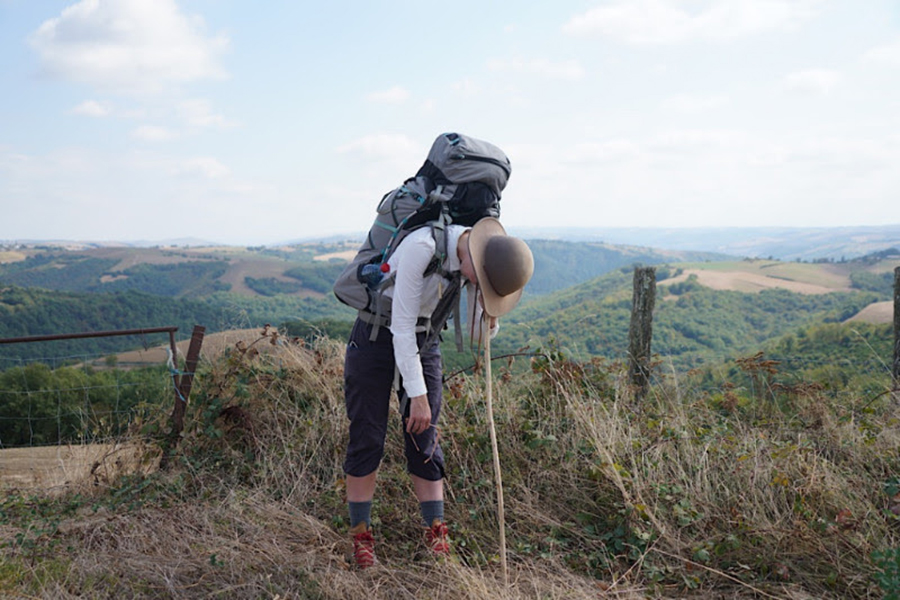Walking from Dunkirk to Barcelona to Measure the Curvature of the Earth
For 112 days Sara Morawetz retraced the 2,000 kilometre journey of two 18th century astronomers, tasked with defining the length of a metre
For 112 days Sara Morawetz retraced the 2,000 kilometre journey of two 18th century astronomers, tasked with defining the length of a metre

On 24 June 2018 artist Sara Morawetz started walking. In sturdy leather boots and a broad-brimmed, blue felt hat, she headed south from Dunkirk, France’s most northerly town. For 112 days, over 2,000 kilometres, Morawetz negotiated exhaustion, monotony, blisters, anxiety, self-doubt, 100-kilometre-per-hour winds, 37°C heat and the Pyrenees. She walked from the North Sea to the Mediterranean. On 13 October, she arrived at her destination: Barcelona.

The walk (étalon, 2018) is a performance in homage to an earlier journey. In 1792 Napoleon ordered two French astronomers, Jean-Baptiste-Joseph Delambre and Pierre-François-André Méchain, to determine a new universal standard unit of measurement. They journeyed from Dunkirk to Barcelona in order to measure the curvature of the earth. It took them seven years. The new unit was a direct result of the data the pair accrued and the calculations they made: one ten-millionth of the distance from the North Pole to the Equator, one mètre-étalon, one metre.
Delambre and Méchain worked in partnership, and throughout her walk Morawetz was accompanied by a succession of artists and writers. Each day, Morawetz and her collaborator took measurements using a GPS receiver, a laser range-finder, and a purpose-built target made of alternating black and white segments. ‘A metre is a distance between two points,’ explains the artist. ‘Throughout the walk is this idea of two points of contact that need to be maintained.’
Morawetz’s first walking collaborator was her husband, Darren Engwirda, a computational mathematics researcher. He wrote a piece of software which allows Morawetz to use her measurements to calculate the radius of the earth, and from that to produce both a provisional daily metre length and a cumulative total. ‘From this I will produce a metre of my own making, a physical representation of the entirety of the journey,’ she told me.

Apart from Engwirda, all of the other collaborators have been women. The French word étalon means not only ‘standard’ but also ‘stallion’ which, for Morawetz, suggests something very masculine inherent in the history of the metre. ‘This act of trying to retrace a journey and remeasure the metre could be a somewhat feminist gesture,’ she says. Before the walk, Morawetz researched the female walkers of the early 20th century when ‘women were given permission to walk in the landscape with a certain degree of agency’. Her walking attire for étalon – the felt hat, long socks, a white shirt and grey cravat – not only marks her apart from other hikers but also gives a nod to these pioneers. ‘As a group of women, we’re trying to create a tactile relationship with the landscape and with measurement as a standardising force,’ she says.
This focus on the tactile (bodily, material) is key for Morawetz. Much of her previous work has involved a performed thinking through of the relationship between time and the body. Previously, she spent a month in Open Source Gallery, New York, living according to the time on Mars, where each day is 2.7% longer than on earth (How the Stars Stand, 2015). 61/60 (2015-ongoing) a life-long performance, involves a single strike of a pair of cymbals to mark each leap second, the unit of time irregularly added to the global clock to keep it in sync with the universe.

From June to October, étalon spanned the seasons. ‘The wheat has now been cut, the sunflowers are dying, the light has changed, the leaves have changed. These are markers of time,’ she told me. But it is not only the landscape that has changed. Morawetz has undergone physical changes too: she feels stronger, she has lost weight. Her blue hat has been bleached yellow by the sun; her boots re-heeled twice. There is a rawness and emotional vulnerability to the fragmented texts she has emailed to those following the project; via Skype in the walk’s final days, she is more upbeat. ‘The landscape changes and I change in it,’ she writes.
In addition to the creation of her own metal metre, Morawetz has been exhibiting images and daily field reports from étalon at Museé des Art et Métiers, Paris since July, as a precursor to a group exhibition, ‘Made to Measure: the seven units of the world’ (to 5 May 2019). She has also posted regular updates to social media throughout the journey. Morawetz contributed to ‘Saunter Trek Escort Parade… (S.T.E.P.)’, a two-part group exhibition of walk-based work which took place at Flux Factory, New York in September and which will be on show at Queens Museum, New York from 28 October until 2 December. Further iterations of étalon will follow.
‘Thinking takes place in the relationship of territory and the earth,’ wrote Gilles Deleuze and Felix Guattari. That is where étalon operates, too: in the painfully fertile friction between abstraction and materiality, between idea and event and body. ‘I made the mistake of falling in love with the theoretical (again) – beguiled by purist ideals,’ Morawetz reveals via email. And she has discovered, what? ‘The rawness of inexactitude. A mind and map laid bare.’
étalon has been assisted by the Australia Council, the QAGOMA Foundation, the Musée des Arts et Métiers, the Art Gallery of NSW, the Cité Internationale des Arts and Pratt Institute.
‘étalon: The Scientific Adventure of Sara Morawetz’ runs at Musée des Arts et Métiers, Paris, until 6 January 2019.
Main image: Sara-Morawetz, étalon, 2018, performance documentation. Courtesy: the artist; photograph: Lucy Parakina





















